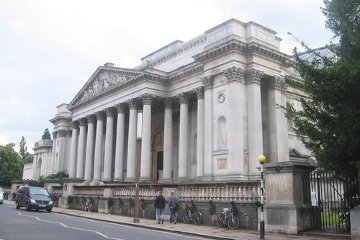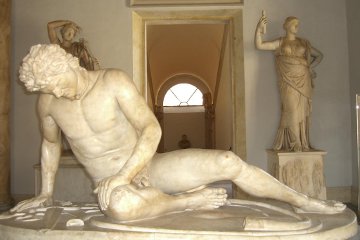The Cambridge Fakes
| Fitzwilliam Museum | 52 12 00.98N 00 07 10.42E | The Fitzwilliam Museum is housed in a magnificent building on the main road south out of Cambridge. |
| Archaeology Museum | 52 12 10.48N 00 07 19.37E | I think I have the right building in Downing Street. The museum is housed inside the college. |
| Art Department | 52 12 02.13N 00 06 36.10E | Where ignorance reigns supreme - but what would you expect from arty types? |

| |
| The grandeur of the Fitzwilliam Museum in Cambridge. |
Cambridge is, of course, known for the excellence of its academic institutions, but it is also home to three fascinating archaeological museums. The first, and probably the most important, is the Fitzwilliam Museum, which has just undergone an extensive refit that, in imitation of the British Museum, has transformed its courtyard into a glass-covered space housing a shop and cafe.
Leaving aside such trivia, we pass in to the collection. The upper story contains some paintings which, for the connisseur, are no doubt very important, but they are less interesting for the archaeologist. It is the ground floor and basement that concern us, for here there is a veritable treasure-house of objects from Greece and Egypt. There is a brick inscribed with the name of Egypt's first pharaoh, serpent wands carried by Egyptian magicians (shades of the story of Moses!), Greek inscriptions and a host more, all excellently laid out and labelled.
Less well-known is the Archaeology Museum, maintained by and housed in the Department of Archaeology in Downing Street. Here are preserved the results of various excavations that were sponsored by Cambridge University, a reasonable basis for a curious collection that ranges from Bronze Age pots excavated in British barrows to Sumerian clay tablets dug out of the soil of Mesopotamia.
Unfortunately, because the Museum was created for the service of the Archaeology Department, its opening hours suit the needs of professors rather than tourists and it is advisable to make certain the museum will be open before spending time hunting for it.
The third museum is in the Art Department in Sidgwick Avenue and consists of plaster casts of a large number of famous scupltures. Of course, it would be ideal to have the originals, but in this imperfect world there can only be one original and for some strange reason the authorities in Florence and Rome and other places are reluctant to transfer their best works to Cambridge. (In any case, plaster casts are not to be sneezed at: one large gallery at the V&A - the Victoria and Albert Museum in London - is devoted to plaster casts of works by Benvenuto Cellini.)
As it would involve considerable time and expense to travel to the homes of all these works of art, it is very convenient to find them all collected together for our delectation.

| |
| The Dying Gaul - the real one - in the Capitoline Museum, Rome. |
The statue that most impressed itself on my mind was the Dying Gaul, which shows a Gaul, identified by his torq and weaponry, slumping on his shield as he bleeds to death from a stab wound. I was surprised to discover that this famous piece of art came from the acropolis of Pergamum, whose forces won a famous victory over the Gauls or Galatians.
Regrettably, all these museums have a reactionary attitude towards photography. The Archaeology Museum was the most enlightened and permitted me to photograph provided it was for personal use only. The Fitzwilliam looked down its nose and finally permitted me to photograph two objects and sent a curator to accompany me and make certain that I did not exceed my limit. The Art Museum, however, refused point blank.
"No, sir," the gilded youth to whom I made application replied, "We do not permit photography of our collection. No major museum does."
"The British Museum does," I objected.
He could, I suppose, have insisted that the British Museum was not "major" compared to his one-roomed Cambridge elite, but instead he stared at me politely but firmly. "No sir, it does not."
As I have an extensive collection of photographs taken in the British Museum with the full cognisance of the authorities, I dared to contradict this representative of the university. He eyed me with vague contempt.
"No, sir. It does not."
In the face of such invincible ignorance there are only two options available to you: either to seize the offender and beat his head to a pulp against something solid or to retreat. I adopted the less violent alternative; I am still not convinced that I did the right thing.





